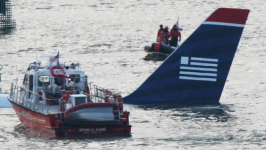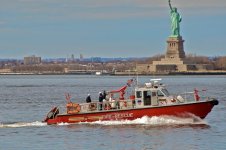NYC fireboat finds new home in Door Co.
Jon Gast
For USA TODAY NETWORK-Wisconsin
View Comments

Mike Cole says it will probably be more than four years before the public sees it and, when it does, it won’t look much like its former self.
But, regardless, his new boat has a story.
Unlike the fireboat Fred A. Busse that is spending its retirement from the Chicago Fire Department providing tours on Sturgeon Bay during the warmer months, the future for the Kevin C. Kane looks far different.
The Kane served as a fireboat in the New York City Fire Department for more than 20 years and was an active participant in some of that city’s extraordinary events during that span.
The Kane lent assistance during 9/11, serving as one of the evacuation and relief vessels after the terrorist attack on the World Trade Center’s twin towers in 2001.
Nearly a decade later, the fireboat would be called upon again when US Airways Flight 1549 suffered catastrophic engine failure and was forced to make a water landing in the Hudson River on Jan. 15, 2009. All 155 passengers were rescued, a remarkable event that was revisited with the recent release of the movie “Sully.”
It was neither of those momentous events that led directly to why that vessel finds itself in Door County, but rather another.
The Kane was damaged in Hurricane Sandy, the epic superstorm that ravaged the East Coast in October 2012. The boat was also in need of a mechanical upgrade, so the city opted for a replacement and auctioned it off.
Unaware of the initial sale, Cole received a break when the person who purchased the 52-foot boat decided he didn’t want it and put it up for sale.
Cole owns Iron Works Construction in Baileys Harbor and one might think that a fireboat wouldn’t necessarily be ideal for marine construction. But Cole, who saw an advertisement for the boat in a trade publication, saw an opportunity to get a larger tug he had been looking for at a decent price.
“It’s a good boat,” said Cole, who added that the fire department might have seen the hurricane damage as an opportunity to get a new vessel. Cole admitted lightheartedly that he can’t find the damage.
Cole saw it as an opportunity to take a well-built vessel and convert it into a working tug. When finished, it won’t look much like the vessel that nuzzled up to the side of the floating US Airways plane eight years ago on the Hudson River.
But Cole is excited to write an entirely new chapter that hopefully won’t require it to make any of the many emergency responses that were part of its illustrious career with the FDNY.
Cole is confident the Kane, named for an FDNY firefighter who was killed in the line of duty, could have served for decades to come.
Built in 1992, it went up for auction alongside the John D. McKean that had been in service since 1938.
“It’s got big horsepower to pull and push,” said Cole. “It was built for heavy seas. It had a top speed of 34 knots.”
Cole used the word “had” since he’s taken 15,000 pounds of firefighting equipment off the boat, including its five water guns and pumps. “It came a foot out of the water and it’ll probably do 36-40 knots when we’re finished,” he said.
But Cole will be adding some weight back on as he converts a one-deck vessel with a pilot house to three, adding crew quarters for those jobs that will require multiple days away from home port.
Cole said his initial interest in the vessel was enough to fly to New York to see the boat and inspect it. He bought it but was disappointed to find that what he had been told about its condition wasn’t exactly true.
What turned out to be a couple parts replacements proved to be a bigger job that delayed bringing the vessel back to Door County. What was expected to be about a 12-day trip involving repairs, sea trials and return to Door County, lasted 10 additional days with the boat arriving a day before Thanksgiving.
“But the response to the boat was amazing, especially in New York from former firefighters,” said Cole, who added that the vessel was an item of curiosity for its entire trip back, which began with a trip through the Erie Canal.
“Actually, I didn’t know much about its history until I got to New York,” said Cole, who got an inkling when he stepped into the pilot house. “Right there on the ceiling is a handwritten card with the cell numbers for the fire chief as well as the numbers for the mayor and governor.”
Cole said he isn’t planning on removing the well-worn card.
“It was assigned to (FDNY) Marine Company No. 6,” said Cole, who said its identification plate now hangs in the company’s station. “I was told they had a formal ceremony with the Kane family when the boat was retired.”
After hearing about the esteem which Kane is held within the fire department and the deeds the boat and its crew performed in his name, Cole said he isn’t about to change the name of the vessel.
“His name will live on with this boat,” said Cole, who expects to have more than a few locals and visitors alike ask him who Kevin C. Kane is once it again hits the water.
He’ll have quite a story to tell.
Jon Gast
For USA TODAY NETWORK-Wisconsin
View Comments

Mike Cole says it will probably be more than four years before the public sees it and, when it does, it won’t look much like its former self.
But, regardless, his new boat has a story.
Unlike the fireboat Fred A. Busse that is spending its retirement from the Chicago Fire Department providing tours on Sturgeon Bay during the warmer months, the future for the Kevin C. Kane looks far different.
The Kane served as a fireboat in the New York City Fire Department for more than 20 years and was an active participant in some of that city’s extraordinary events during that span.
The Kane lent assistance during 9/11, serving as one of the evacuation and relief vessels after the terrorist attack on the World Trade Center’s twin towers in 2001.
Nearly a decade later, the fireboat would be called upon again when US Airways Flight 1549 suffered catastrophic engine failure and was forced to make a water landing in the Hudson River on Jan. 15, 2009. All 155 passengers were rescued, a remarkable event that was revisited with the recent release of the movie “Sully.”
It was neither of those momentous events that led directly to why that vessel finds itself in Door County, but rather another.
The Kane was damaged in Hurricane Sandy, the epic superstorm that ravaged the East Coast in October 2012. The boat was also in need of a mechanical upgrade, so the city opted for a replacement and auctioned it off.
Unaware of the initial sale, Cole received a break when the person who purchased the 52-foot boat decided he didn’t want it and put it up for sale.
Cole owns Iron Works Construction in Baileys Harbor and one might think that a fireboat wouldn’t necessarily be ideal for marine construction. But Cole, who saw an advertisement for the boat in a trade publication, saw an opportunity to get a larger tug he had been looking for at a decent price.
“It’s a good boat,” said Cole, who added that the fire department might have seen the hurricane damage as an opportunity to get a new vessel. Cole admitted lightheartedly that he can’t find the damage.
Cole saw it as an opportunity to take a well-built vessel and convert it into a working tug. When finished, it won’t look much like the vessel that nuzzled up to the side of the floating US Airways plane eight years ago on the Hudson River.
But Cole is excited to write an entirely new chapter that hopefully won’t require it to make any of the many emergency responses that were part of its illustrious career with the FDNY.
Cole is confident the Kane, named for an FDNY firefighter who was killed in the line of duty, could have served for decades to come.
Built in 1992, it went up for auction alongside the John D. McKean that had been in service since 1938.
“It’s got big horsepower to pull and push,” said Cole. “It was built for heavy seas. It had a top speed of 34 knots.”
Cole used the word “had” since he’s taken 15,000 pounds of firefighting equipment off the boat, including its five water guns and pumps. “It came a foot out of the water and it’ll probably do 36-40 knots when we’re finished,” he said.
But Cole will be adding some weight back on as he converts a one-deck vessel with a pilot house to three, adding crew quarters for those jobs that will require multiple days away from home port.
Cole said his initial interest in the vessel was enough to fly to New York to see the boat and inspect it. He bought it but was disappointed to find that what he had been told about its condition wasn’t exactly true.
What turned out to be a couple parts replacements proved to be a bigger job that delayed bringing the vessel back to Door County. What was expected to be about a 12-day trip involving repairs, sea trials and return to Door County, lasted 10 additional days with the boat arriving a day before Thanksgiving.
“But the response to the boat was amazing, especially in New York from former firefighters,” said Cole, who added that the vessel was an item of curiosity for its entire trip back, which began with a trip through the Erie Canal.
“Actually, I didn’t know much about its history until I got to New York,” said Cole, who got an inkling when he stepped into the pilot house. “Right there on the ceiling is a handwritten card with the cell numbers for the fire chief as well as the numbers for the mayor and governor.”
Cole said he isn’t planning on removing the well-worn card.
“It was assigned to (FDNY) Marine Company No. 6,” said Cole, who said its identification plate now hangs in the company’s station. “I was told they had a formal ceremony with the Kane family when the boat was retired.”
After hearing about the esteem which Kane is held within the fire department and the deeds the boat and its crew performed in his name, Cole said he isn’t about to change the name of the vessel.
“His name will live on with this boat,” said Cole, who expects to have more than a few locals and visitors alike ask him who Kevin C. Kane is once it again hits the water.
He’ll have quite a story to tell.


